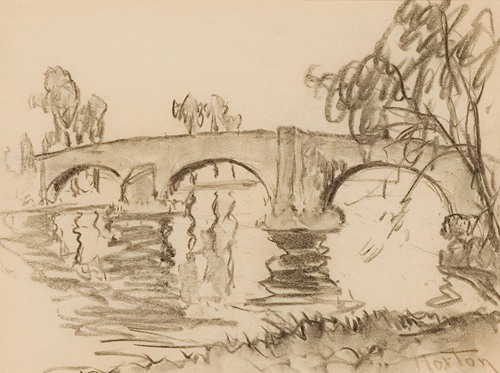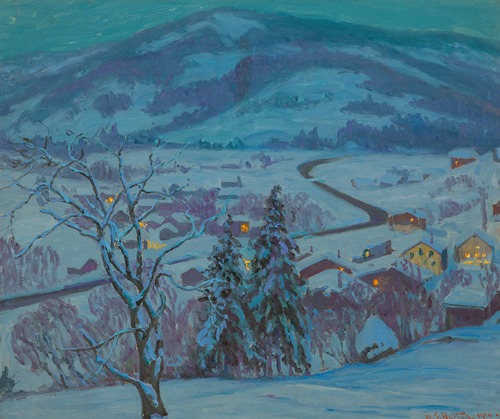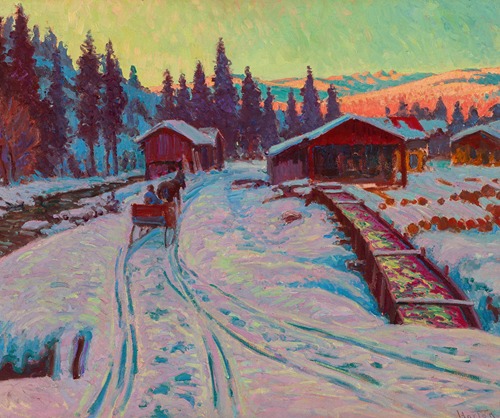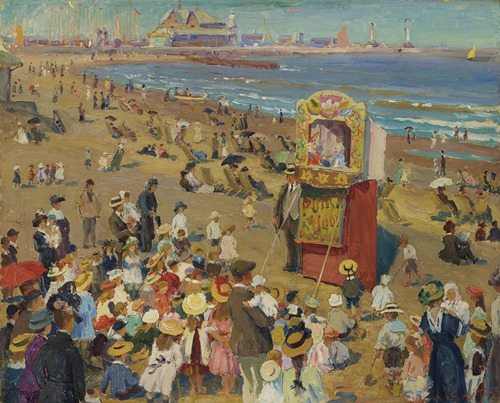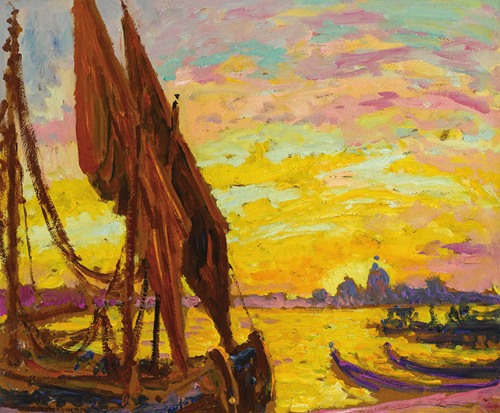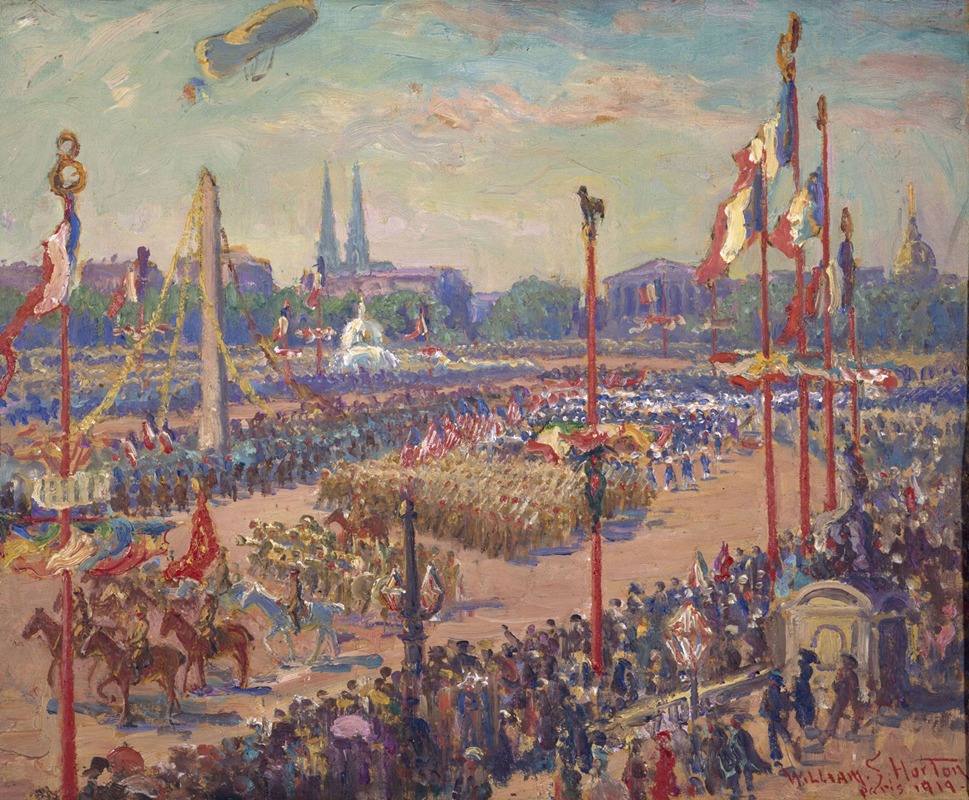
William Samuel Horton was an American impressionist painter who mostly painted landscapes and water scenes. He spent a large part of his life in Europe, mostly in France and England, where he trained and developed his impressionist style with major impressionist artists. He is considered by art critics, gallerists and museums to be one of the major members of American impressionism, following on painters such as Mary Cassatt and Childe Hassam, but with a production mostly centered on European motives.
William Samuel Horton was born in Grand Rapids, Michigan on November 16, 1865, in a wealthy family. As from 1870 he grew up in Lisbon, North Dakota.. By the age of twelve, Horton was actively drawing and painting; two years later he took the position of illustrator for North West Magazine. He left home in 1883, without his parents' approval, to study at the Art Institute of Chicago, and the Art Students League of New York (apparently, this departure led his parents to disinherit him).
From 1886 to 1890, he worked as illustrator for the 'North West Magazine', and spent two years in North American Indian Cantonments.
In 1892, Horton married ‘debutante’ Carlotta Lorrie Gray, a well-to-do member of New York City society, daughter of a shipowner. In 1897, their son, William ‘Gray’, was born in Paris, France.
They moved to Europe in 1893, first in Holland and then in France. In 1895, Horton joined the Académie Julian art school in Paris where he studied with teachers such as Jean-Joseph Benjamin-Constant and Jean-Paul Laurens. There he met and befriended artists such as Whistler, Monet, Degas and Pissarro, and progressively developed his own style, often very close to Impressionism, sometimes early Pointillism, maybe[weasel words] inspired by Pissarro.
Horton moved to England in 1918, but continued to travel frequently throughout Europe and painted scenes in England, France, Switzerland and Italy, as well as in New York where he returned between 1924 and 1930. Horton travelled to Norway in 1934, then in Asia in 1935 (China, Singapore, India, Indonesia, Red Sea), while continuing to paint actively, including on board liner ships (see, for instance, his pastels 'Sketch from the 'Empress of Norway', 1934, or 'Shipping on the Red Sea', 1934).
He died in Paris on October 1st 1936, close to 71 years old, and four years after his wife had passed-away. Horton, and his wife, had been relatively wealthy and had rarely put his works for sale. At his death, his son William 'Gray' inherited more than one thousand works: oils, drawings, pastels, etc. In 1939, a first retrospective exhibition of his works was organized by his son at the Galerie Charpentier in Paris, with a text contributed by the French art critic Louis Vauxcelles.
His son William ‘Gray’, a Captain with the Scots Guards, married in 1930 a British woman, Gwendoline Anna Le Bas, whose father, Edward Le Bas, was also an artist. William ‘Gray’ and Gwendoline had two children, Robin and Carlotta (Carlotta Edwina Gray Hadley); the latter made large donations of her grandfather's paintings, in particular to the Musée Bonnat-Helleu of Bayonne, southwestern France, where he had stayed and painted, including in the nearby coastal city of Biarritz.
Horton developed his own impressionist style, focused on colors and the effects of light on colors and shapes. Like Monet and other renowned impressionist painters, Horton used to paint the same outdoor motif several times, at different times of the day, to study and render the variations of light, shadows and forms.
His best-known paintings are landscapes of the US and Europe, including city skylines, beach, coastal and mountain scenes. He painted several snowy landscapes, including in the Swiss Alps, and Monet is said to have named Horton “the greatest painter of snow who ever lived”.
Horton also painted cityscapes, especially in Paris, London, Venice and New York City. In the latter city he painted several views of high buildings, 'towers', such as the Ritz Tower and the Heckscher Tower, which are famous for their vibrant light, in a pure impressionist style. Some of William S. Horton paintings of cityscapes are exhibited at the 'Villes américaines' (American Cities) exhibition organized at the 'Musée Franco-Américain' of Blérancourt ('National Museum of French-American Friendship and Cooperation'), north-east of Paris, from September 2021 to mid-February 2022.
According to art critics and galleries, Horton's total work is estimated to exceed one thousand oil paintings, drawings, pastels, illustrations, etc, most of it was initially inherited by his son William 'Gray' in 1936. Since then, part of his works have remained with his descendants, while other works have been sold through galleries or donated to some museums.
Horton started to exhibit his works in the US (National Academy of Design, New York City, 1888–96; Boston Arts College, 1890; Pennsylvania Academy of the Fine Arts, 1890–1912; Art Institute of Chicago, 1897–1909), then in France (Paris Salon des artistes français, 1895, 1897–99; Paris Salon d'Automne; Galerie Bernheim Jeune, Paris, 1898; International Expo, Nantes; 1904, Galerie Georges Petit and Galerie Rue Lafitte, Paris, 1905; Orléans, 1905), then again in the US (Ainslie Galleries, New York, 1925, Hirschl & Adler's, 1960)..
After his death, a retrospective exhibition was organized by his son in May 1939, held by Galerie Charpentier in Paris; the catalog of this show included a seven-page 'Appreciation' text by the French art critic Louis Vauxcelles. Later on, various exhibitions were organized by several US galleries (Hirschl & Adler's, New York City, 1960; Vose Gallery, Boston, 1966 and c.1980s; Knoedler Gallery, New York City, 1974; Robert Rice Gallery, Houston, 1979; Hammer Gallery, New York City, 1981; Shreve, Crump & Low, Boston, 1997)
